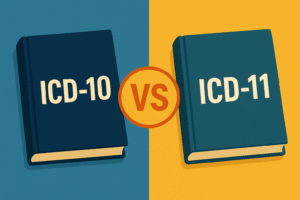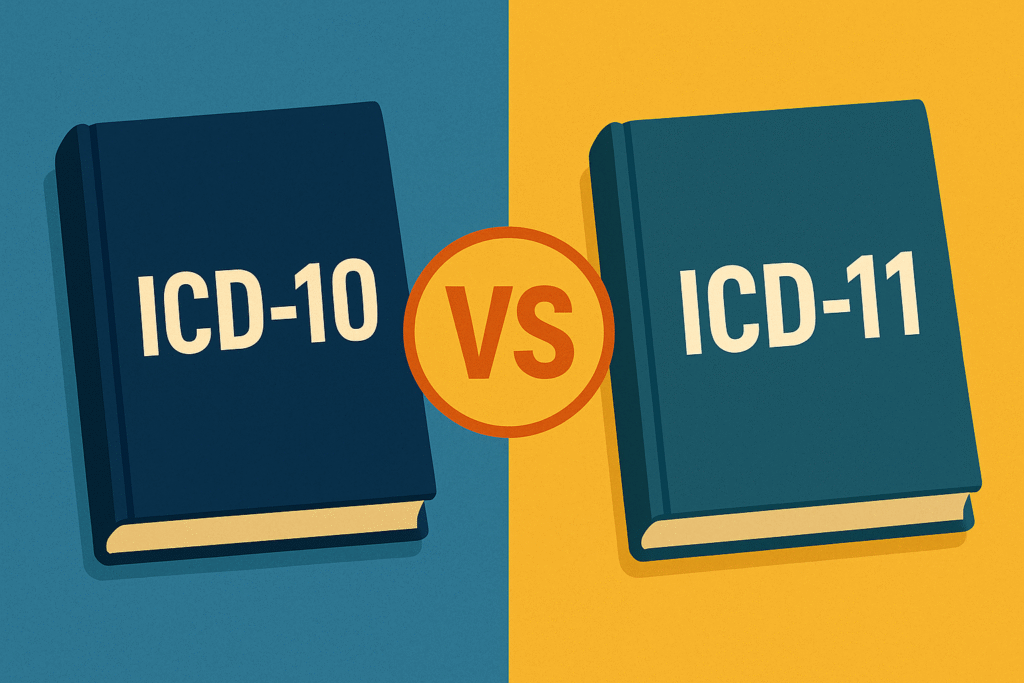While the United States made a major shift to ICD-10 in 2015, the global healthcare community has already moved on. The World Health Organization (WHO) endorsed the International Classification of Diseases, 11th Revision (ICD-11) in 2019, and it took effect globally in 2022. For U.S. medical practices, this marks a new, inevitable transition that will fundamentally change medical billing and coding, clinical documentation, and data analytics. While there is no firm implementation date for the U.S. yet, a shift is likely in the coming years. Understanding the key differences between the two systems is crucial for practices to prepare for this significant evolution in healthcare classification.

Key Differences: What’s New in ICD-11
The most significant distinction between ICD-10 and ICD-11 isn’t just a number change; it’s a paradigm shift. ICD-10 was a linear, print-based system that was adapted for digital use, while ICD-11 was designed from the ground up for the modern digital health environment. This digital-first approach brings a host of improvements:
- Vastly Expanded Code Set: ICD-11 has over 55,000 unique codes, a massive increase from ICD-10’s approximately 14,000. This expansion allows for far greater specificity and detail in coding. It includes new categories for conditions like gaming disorder, chronic pain, and diseases of the immune system, which were not well-defined in ICD-10. This granular detail can lead to more accurate clinical documentation and better patient care.
- Flexible and Intuitive Structure: ICD-11 uses a different alphanumeric format and introduces a new concept called “post-coordination”. This allows coders to combine a “stem code” with one or more “extension codes” to describe a complex condition in a highly detailed way. For example, instead of searching for a single, long code for a specific injury with a certain severity, you can combine codes to build a precise clinical picture. This approach makes coding more intuitive and reduces the need for the extensive, complex code lists of ICD-10.
- Seamless Digital Integration: As a digital-native system, ICD-11 is designed to integrate smoothly with Electronic Health Records (EHR) and billing software. It utilizes an Application Programming Interface (API) that enables real-time data exchange and automatic updates. This is a game-changer for the revenue cycle, as it promises to streamline workflows, reduce manual data entry, and minimize administrative burden.
- Improved Search and Usability: The new system comes with advanced digital tools, including an online coding browser and a built-in search function that uses natural language. This feature can help coders and clinicians find the correct codes more easily, reducing the learning curve and the likelihood of errors.
Impact on U.S. Medical Practices
The transition to ICD-11 will have a profound impact across all aspects of a medical practice, from the front office to the back-end revenue cycle management.
- Financial Implications: While the transition will require significant initial investment in technology and training, the long-term financial benefits are substantial. The increased specificity of ICD-11 codes is expected to lead to a higher clean claim rate, which means fewer claim denials and faster reimbursement. This improved cash flow is vital for the financial health of any practice. Accurate coding also plays a key role in supporting value-based care models, where reimbursement is tied to quality and outcomes.
- Training and Staffing: The biggest challenge will be preparing staff. Coders, billers, and even physicians will need extensive training to master the new coding structure and documentation requirements. Practices should start budgeting and planning for this education now. Inadequate training could lead to a rise in coding errors, which would directly disrupt revenue and potentially lead to costly audits.
- Data and Analytics: The granular data provided by ICD-11 is a boon for public health and practice-level analytics. For U.S. providers, this data can be used to improve disease surveillance, track population health trends, and inform clinical research. At the practice level, the detailed information can help in identifying patient populations for specific interventions and optimizing resource allocation.
The eventual shift to ICD-11 is not a question of if, but when. U.S. medical practices that begin to understand and prepare for this transition now will be well-positioned to leverage its benefits, from Emerge RCM to better patient care.
5 FAQs About ICD-10 vs. ICD-11
Q1: What is the current timeline for the U.S. transition to ICD-11?
A1: The U.S. has not set an official date for ICD-11 implementation. The process involves a federal rulemaking and public comment period, which can take several years. However, industry experts anticipate a transition will occur within the next decade.
Q2: Will ICD-11 replace CPT codes?
A2: No. ICD-11 is a diagnostic coding system used to classify diseases and conditions. CPT (Current Procedural Terminology) codes are used to describe medical procedures and services. The two systems serve different purposes and will continue to be used together for billing in the U.S.
Q3: How will ICD-11 impact my practice’s claim denial rate?
A3: While there may be an initial spike in denials during the transition period due to the learning curve, ICD-11 is expected to reduce denials in the long term. The increased specificity and structured coding should lead to more accurate and complete claims, thereby improving your practice’s clean claim rate.
Q4: Will a practice still need to perform dual coding during the transition?
A4: It’s highly likely. To ensure continuity of care and billing, practices will likely need to maintain the ability to code in both ICD-10 and ICD-11 for a period of time. This will allow for claims processing from different payers who may transition at varying speeds.
Q5: What’s the biggest challenge for my practice in preparing for ICD-11?
A5: The most significant challenge is ensuring your staff is adequately trained. The new coding structure, including the use of post-coordination, is a major departure from ICD-10. Without proper education for your coders and clinical staff, your practice could face a temporary drop in productivity and a rise in coding errors.


